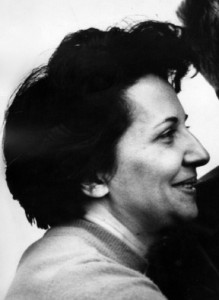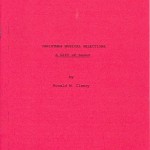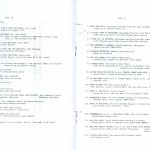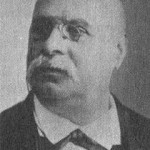Christmas Classics PERSON OF THE DAY: Jack Rollins
On this day in 1906, Walter E. “Jack” Rollins was born in Scottdale, Pennsylvania. Better known as Jack Rollins, he is the songwriter credited with co-writing, supposedly with Steve Nelson, the Christmas holiday song Frosty the Snowman that is part of AMERICAN CHRISTMAS CLASSICS. That success came in 1950, just a year after Rollins, and supposedly Nelson again, collaborated on the popular Easter song Here Comes Peter Cottontail.
Rollins also co-wrote the song Smokey the Bear in 1952 after a wildfire swept across the Capitan Mountains in New Mexico, during the course of which firefighters noticed a lone bear cub climbing up a charred tree to escape being further burnt from the flames. The cub was rescued from his perch and given immediate veterinary care and ultimately was sent to the National Zoo in Washington. The story about the bear cub and its rescue lead to a national public service campaign to prevent forest fires with Smokey the Bear serving as mascot.
Rollins achieved a fair level of success with his children’s holiday songs, especially with the Gene Autry recording of Frosty the Snowman that sold over a million records. Rollins also co-wrote others songs for such country singers as George Jones and Eddie Arnold. Success, however, seemed to have come late in his career, one dotted with menial jobs. In 1940 he worked for a bakery. Eight years later he was a baggage clerk for Penn Station in New York. It was at that time when the 44 year old baggage clerk found the time to pen Frosty the Snowman and a number of other songs, and practically every night Rollins used to ask Frank (Zeb) Martello, the host of WOR mutual radio, to play them.
According to a letter from a Martello family member, Rollins and the radio host became friends and together they may have written five songs, including Rollins’ two most popular holiday songs Frosty the Snowman and Peter Cottontail. But Rollins asked Martello to take his name off the songs because some other well-known people, including “a guy by the name of Steve Nelson, for one, wanted his name on the songs before he would promote them.”
After the two songs became big hits, Martello was asked by his wife why he had removed his name from the two songs, insisting that he was always being the nice guy. Martello replied “Jack has a lot of talent, he deserves a break.” When asked if he ever regretted doing that, Martello said, “not really, but I guess mom could have used the money.”
Jack Rollins died in Cincinnati on January 1, 1973. The kind-hearted Zeb Martello on hearing the sad news was quoted to have said, “God Bless Jack, but I still have a lot to be thankful for.”
Christmas Classics PERSON OF THE DAY: Gloria Shayne
On this day ninety years ago, Gloria Adele Shain was born of a Jewish family in Brookline, Massachusetts. She changed her name to Gloria Shayne early in her professional career as a pianist and composer. In the 1940s she moved to New York,and it was there where she made her mark.
In the world of Christmas music she is famed for composing Do You Hear What I Hear? in collaboration with her husband Noel Regney, a Frenchman.
The Shayne and Regney union was a story of romance. They met in the early 1950’s when the Frenchman came to the Beverly Hotel in New York, now known as the Benjamin Hotel, where Shayne was playing the piano. Both were duly smitten on their chance meeting and a month later the two lovers were married.
Do You Hear What I Hear?, although often taken for a Christmas carol, was actually composed by the husband and wife team as a hymn of peace, one borne out of a sense of desperation and fear of war because of the looming Cuban Missile Crisis. Both composers had not forgotten about the horrors of war. During the World War II years Shayne worked for the Jewish Welfare organization at a time when millions of Jews were being slaughtered by the Nazis. Regney, trained as a classical composer, witnessed its terror first hand when he was conscripted by the German Army, even though he was a Frenchman, but soon deserted it to join the French Resistance.
Shayne and Regney were especially fond of the phrase “Pray for peace, people everywhere!” in the carol’s last stanza because it emphasized the rationale for the song. Somehow their hymn of peace became part of the Christmas carol repertoire, perhaps because of Regney’s lyrical imagery of lamb, shepherd boy, and the Child Jesus sleeping that could easily be associated with the Nativity scene.
Shayne and Regney collaborated on a number of famous songs, including Rain, Rain Go Away first performed by Bobby Vinton and Sweet Little Darlin’ first performed by Jo Stafford. But she also enjoyed success on her own, including writing the music and lyrics for Goodbye, Cruel World, recorded by James Darren, and co-writing The Men in My Little Girls’ Life, performed by Mike Douglas, and Almost There that was first sung by Andy Williams.
Gloria Shayne divorced Noel Regney in 1973. She remarried, and in 2008 she died at home in Stamford, Connecticut of lung cancer. She will be most remembered here for her contributions to Do You Hear What I Hear?, a song of peace that eventually spawned a lovely Christmas carol.
Christmas Classics PERSON OF THE DAY: Bobby Helms
On this day in 1933, Robert Lee Helms was born in Bloomington, Indiana. Better known as Bobby Helms, he was a country singer and the original recording artist of Jingle-Bell Rock, the first Christmas holiday song noted for its rock n’ roll flavor. It was released by Decca Records on December 23, 1957, a hundred years after the copyright of Jingle Bells, which may not have been totally coincidental. The song rapidly rose to #6 on the Pop Charts and has since been reprised every Christmas season.
Bobby Helms rise to stardom actually began earlier that year with the release of Fraulein, a country song, which to the surprise of country aficionados, fared well on the pop charts, and later in 1957 with My Special Angel, Helms’ biggest hit that sold over a million records.
Jingle-Bell Rock, however, was the brainchild of an very unlikely pair of the songwriters: Joseph Carleton Beal, a public relations man and author, and Texas-born James R. Boothe whose career was largely devoted to advertising. Jingle-Bell Rock was their sole claim to fame in the world of Christmas music.
Although Bobby Helms continued a productive career in country music that included touring with his Bobby Helms Show and promoting a yearly musical festival in his native Indiana, not to mention he owned three night clubs, he never again achieved the soaring heights when Jingle-Bell Rock topped off what was a very, very good year.
Christmas Classics PERSON OF THE DAY: John Wesley Work, Jr.
Also on this day in 1871, John Wesley Work, Jr. was born in Nashville, Tennessee. Considered one of the first, if not the first, serious black collector of Negro folk songs, he too studied Latin and Greek, as well as history, and taught the two classic languages after he received a Master’s degree from Fisk University in 1898.
For the next twenty-five years Work Jr. became a leader in the effort to study and preserve Negro spirituals. At the same time he organized Fisk singing groups, and with the help of his wife Agnes and his brother Frederick Jerome Work, collected and published a number of collections of slave songs and spirituals. The first of these collections was New Jubilee Songs as Sung by the Fisk Jubilee Singers (1901).
Six years later he published, and may have composed, the remarkable spiritual Go Tell It on the Mountain, as part of New Jubilee Songs and Folk Songs of the American Negro.
Many of the spirituals the Works collected had originally been sung by their forebears as they toiled in the fields, or at difficult manual labor, during the dark age of slavery. It was one way of establishing relationships and feeling that God was near. The story of Christmas, of God’s Son being born as man to redeem and free man of his sins, was important in itself and as a symbol of hope in their quest for freedom
The legacy of Negro spirituals was important to Work Jr. as he became both the leader and performer of the Fisk University Jubilee Singers, the historic choral group founded in 1871 for the purpose of raising funds for the post-Civil War black college whose severe financial problems almost shut the school down. The Jubilee Singers, who took their name from the year of freedom in the Bible, were quite successful on their tours of the United States and Europe, which included a bravo performance for Queen Victoria of England, and in the process they raised the Negro spiritual to an art form.
For eighteen years Work Jr. served as leader of the Jubilee Singers until negative opinion set in at Fisk against the Negro spiritual as only a painful reminder of slavery. This groundswell of negative feelings toward black folk music forced Work Jr. to resign his leadership post in 1923. For the balance of his life, he served as president of Roger Williams University until his death on September 7, 1925.
Christmas Classics PERSON OF THE DAY: Rev. Charles Lewis Hutchins
Rev. Charles Lewis Hutchins was born on this day in 1838. He was an Episcopal minister who graduated from the General Theological Seminary, New York City. He is known for producing a number of books and hymnals for the Episcopalian Church, including his largest volume Carols Old and Carols New: For Use at Christmas and Other Seasons of the Christian Year (Boston: Parish Choir, 1916). The massive collection contained 751 carols, about 470 dedicated to Christmas, and it remains one of the largest ever printed in the English language. The carols were international in scope, mostly from Europe and the United States, and included both favorite and lesser known carols.
Carols Old and Carols New: For Use at Christmas and Other Seasons of the Christian Year had a limited printing of a thousand copies, but it contained unusual features for its day, such as a preface, a composer and music source index, a first-line index, and some information about the authorship of carols.
Rev. Hutchins died on August 17, 1920 in Concord, Massachusetts. He is buried in Sleepy Hollow Cemetery, a famous last resting place for some of New England’s great 19th century authors and transcendental poets, as well as Katherine K. Davis, the composer of the popular carol The Little Drummer Boy.
Christmas 1988 Starts Me on the Yellow Brick Road
In 1988 I thought it would be a neat idea to share the riches of my Christmas music collection. So for Christmas I gift-wrapped four audio cassettes of the finest recordings from my collection and gave them to family and friends. Each gift collection was accompanied by an 8-page type-written directory with a Chinese red cover titled “A Gift of Sound.” Besides having a decorative, though primitive look, the directory of song titles was intended to be easier on the eyes than my barely legible long-hand. Just imagine writing the same information on cassette index cards four times twelve, or forty-eight total! The thought was enough to give me writer’s cramps. My quaint IBM Selectric II typewriter, however, saved me the trouble and as a result the directory included not only selection titles, but also brief liner notes that sometimes indicated the origin of each carol, holiday song, or instrumental piece.
Some of my friends included those of the Jewish faith married to Christian partners. They admitted that although they usually felt left out at Christmas, they were indeed appreciative of my eclectic Christmas music gift. What made the collection special for most was the quality of the music. Quite unlike what they were accustomed to hearing during the holidays, it encompassed Gregorian chant, once the Christmas music of its day, and such classical pieces as "Anima Nostra,” Bach’s “Christmas Oratorio,” the German motet ""Hort zu lieben Leute," and the Spanish villancico, "Riu, Riu, Chiu” just to name a few. The collection was rounded out by lyrical English carols from the 16th and 17th centuries, and better known traditional fare, particularly carol hymns as "O Come, O Come Emmanuel” and “Adeste Fidelis,” or classic holiday songs as “White Christmas,” and “The Christmas Song.” In all, the four cassette collection totaled one hundred and twenty-four titles. Most came from England, France, Germany, and the United States. Entries from Austria, Czechoslovakia, Poland, Italy, and Sweden were also part of the mix. By the end of the 1988 Christmas season I was being encouraged by several friends to do something about my great interest in Christmas music, suggesting that I should pursue my interest and take advantage of my college degree. This I did. And in 1989 I was on my way.
SPECIAL PERSON OF THE DAY – Émile Waldteufel (December 9, 1837 – February 12, 1915)
The composer of Les Patineurs, Op. 183, Émile Waldteufel died in Paris and is buried at Cimetière du Père Lachaise there. The composer was born in Strasbourg, France to a Jewish Alsatian family of musicians. In 1882 he composed the best-known waltz of his career – Les Patineurs (a.k.a. "The Skaters’ Waltz" in English). Inspired by the Cercle des Patineurs, or "’Rink of Skaters’ at the Bois de Boulogne in Paris, the waltz has since been played in various venues, from concert halls to movies such as The Hollywood Revue of 1929 and Chariots of Fire, to music games like Gamecube’s “’Dance Dance Revolution Mario Mix” and Arc System Works’ “Princess on Ice.”
Waldteufel’s famous waltz evokes wonderful imagery: a poised skater gracefully gliding along the ice and swirling about a ring of other skaters as part of the wintry atmosphere. The delightful music includes the sound of bells that adds a nice touch to the outdoor scene. The noted conductor Arturo Toscanini led the NBC Symphony Orchestra on January 28, 1945, at Carnegie Hall, New York, in a fine RCA Victor recording of Les Patineurs
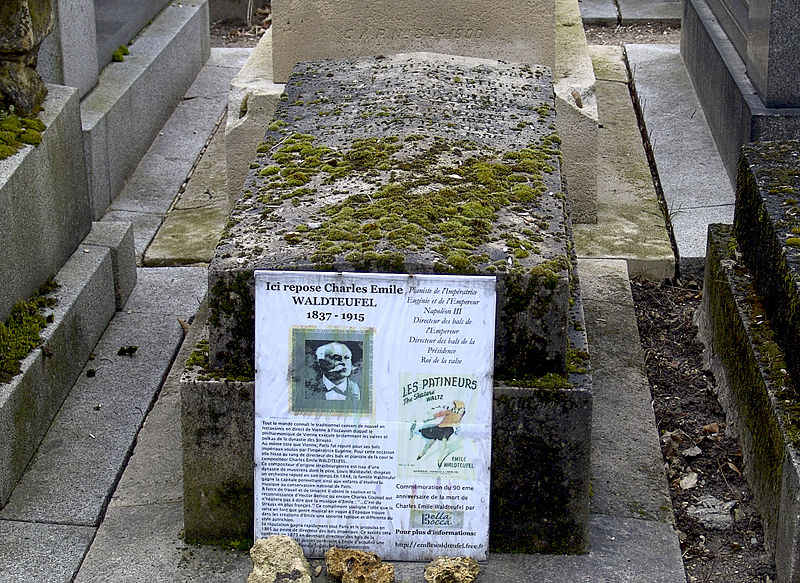
Grave of Émile Waldteufel

